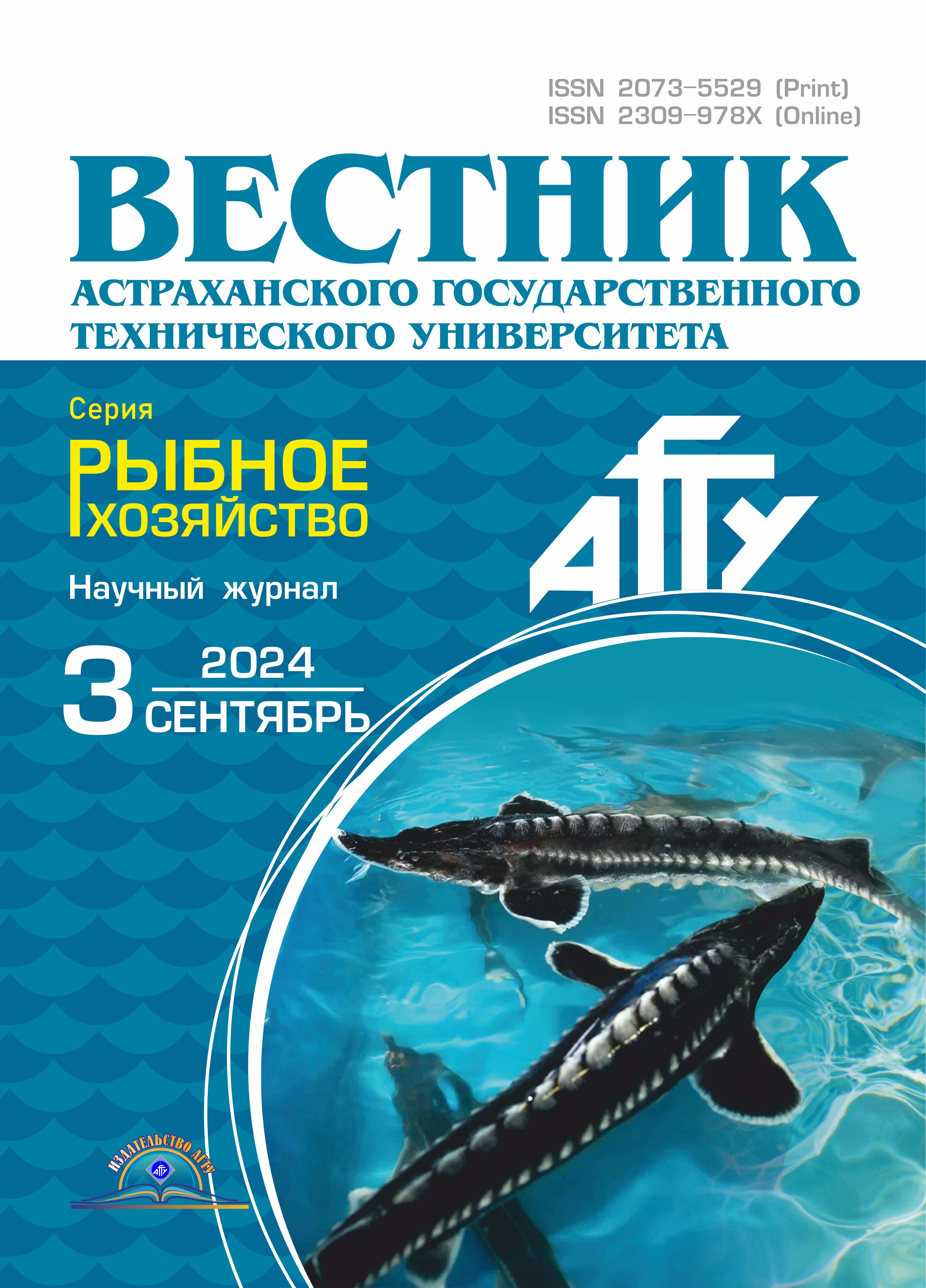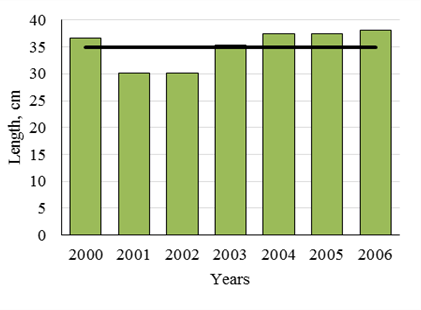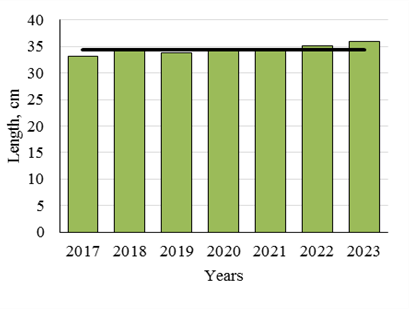Kalinigrad, Russian Federation
Russian Federation
The work is devoted to changes in the biological parameters of the freshwater form of whitefish under conditions of changing fishing intensity. During the historical period in Lake Vishtynetskoye maximum catches reached 4.5 tons in the beginning of 2000, the catch ranged from 0.1 to 2.0 tons (average 0.6 tons), this is a period of low TAC development (fluctuations from 100 to 10%, average 50%). In the period 2017-2022, catches amount to 0.6-1.0 tons (average 0.96 tons), a period of high TAC development (fluctuations from 50 to 100%, average development 75%). The material for the work was data obtained during the study of commercial catches (in the period 2000-2006) and data obtained from the results of control catches (2017-2022). In total, more than 3,000 networks were performed. The data on the size-species structure of the ichthyocenosis, the distribution of fish by depth and the size structure of whitefish are provided. Whitefish is an important component of the ichthyocenosis, accounting for up to 20% of the catch; maximum catches occur at depths of 15-25 meters. In control catches whitefish is found with a length from 15 to 53 cm. It is shown that in the compared periods there was a change in the average body length, it decreased by 0.6 cm, with an increase in average weight by almost 50 g. There was also an increase in the average age of whitefish, from 4.5 years to 5 years. The detected changes in the biological parameters of whitefish indicate a stable state of the population and the absence of a negative impact on it from fishing in the modern period, which indicates the correct determination of the TAC value.
whitefish, Lake Vishtynetskoe, catch, biological characteristics, structural indicators
Introduction
The whitefish Coregonus lavaretus (Linnaeus, 1758) is a polymorphic complex species, different forms of which inhabit water bodies from the North Atlantic to Alaska and Canada [1]. In water bodies of Russia it is found in rivers, lakes and estuaries of the Arctic Ocean basin from the White and Barents Seas to Chukotka, including in the Baltic Sea basin, forming numerous allopatric and sympatric groups within its range [2, 3].
The biodiversity of whitefish is one of the main factors in justifying the creation of specially protected natural areas in the north of Russia [4]. With a vast range and the presence of many ecological forms, whitefish are objects of intensive breeding and fishing. This allows to use them as models for solving of biological problems, as well as for improving the biotechnology of artificial reproduction and developing practical measures for their harvesting [5].
In the Kaliningrad region there are two ecological forms of whitefish. An anadromous whitefish that feeds in the Baltic Sea and enters in the Curonian Lagoon for spawning in autumn [6]. The second ecological form of whitefish – residential freshwater – lives in the deep-water oligotrophic Lake Vishtynetskoe. These forms of whitefish are completely isolated from each other, since the migratory whitefish does not have the opportunity to pass through the river systems from the Curonian Lagoon to Lake Vishtynetskoye, and the Vishtynets whitefish has its own spawning grounds directly in the lake [7]. The whitefish fishery in Lake Vishtynetskoe was well organized during the Soviet period, so in the 1970s, when the main tool for whitefish fishing was a 500-meter seine with a mesh pitch of 32 mm, the maximum whitefish catch was 4.5 tons in 1972. After the collapse of the Soviet Union, seine fishing was stopped, and in the early 90s of the last century, catches did not exceed 1 ton. In the early 2000s. catches ranged from 0.1 to 2.0 tons, averaging 0.6 tons (Fig. 1).

Fig. 1. Whitefish catch in Lake Vishtynetskoye in the period from 2000 to 2010 [8]: TAC – total allowable catch
In recent years, whitefish fishing in the lake has been quite intensive and the average catch in the period from 2017 to 2022 was 0.96 tons (Fig. 2).

Fig. 2. Whitefish catch in Lake Vishtynetskoye in the period from 2017 to 2022 [8]
Currently, there are practically no works devoted to the study of biological parameters of whitefish in Lake Vishtynetskoye; similar works were conducted more than 10 years ago [9], while according to earlier studies, the weight and size indicators of whitefish in catches in Lake Vishtynetskoye decreased every year until the early 2000s [10]. In the modern period, studies of such parameters were conducted to a greater extent only in relation to whitefish from the Curonian Lagoon, since work is being carried out in relation to it to restore the stock [6, 11]. In this regard, the purpose of our work is to describe the biological parameters of whitefish in Lake Vishtynetskoye in the modern period.
Material and research methods
Lake Vishtynetskoye is located in the southeast of the Kaliningrad region in the Nesterovsky district. Its eastern shore adjoins the territory of Lithuania, and its southern shore is located near the border with Poland (Fig. 3).
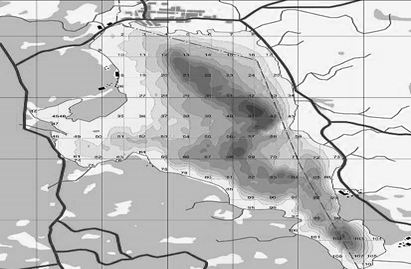
Fig. 3. Map of the area of Lake Vishtynetskoe [12]
The length in the paper is commercial, weight is full. The amount of effort is defined as the catch per 25 m of net/day (kg/f).
The materials for the work were data from commercial catches (period 2000-2006). Fishing during the specified period was carried out with nets with a mesh pitch of 45-50 mm. In the period 2017-2022, the ana-
lysis was carried out based on the data of test catches with nets with a mesh pitch of 10 to 70 mm. During the specified period 3,017 net sets were carried out. Biological parameters were compared using nets with the same mesh pitch. Test catches were carried out in the zone of typical biotopes in such a way as to obtain a reliable characteristic of the distribution, species and size composition of whitefish in the reservoir as a whole. The nets were set for 24 hours. Processing was carried out according to standard methods [12, 13]. The calculations were processed using the IAS “RYBVOD” [14] and the graphic package of the Excel program (Microsoft, USA).
Results and discussion
The ichthyocenosis of Lake Vishtynetskoye in the study period (2017-2023) is represented by 14 species. In nets with a mesh pitch of 10-18 mm, ruff, roach and perch predominate, the catch of medium-sized (20-35 mm) nets is represented by perch, roach, whitefish, burbot, pike and tench. In nets with a mesh pitch of more than 40 mm, such species as roach, pike, perch, burbot, bream, tench and whitefish are noted. The highest catch rates of whitefish were observed in nets with a mesh pitch of 30-50 mm, the maximum density is achieved in nets with a mesh pitch of 35 mm (Fig. 4).

Fig. 4. Size-species structure of ichthyocenosis (by biomass), 2017-2022
Analysis of control catches by depths shows that the highest ichthyomass indicators are observed in the coastal zone and are provided by two species – perch and roach. At depths of 0-5 m, the density of the fish population provides high catches (more than 8 kg/industrial effort). At depths of more than 20 m, the density of the fish population does not reach 1 kg/industrial effort (Fig. 5).
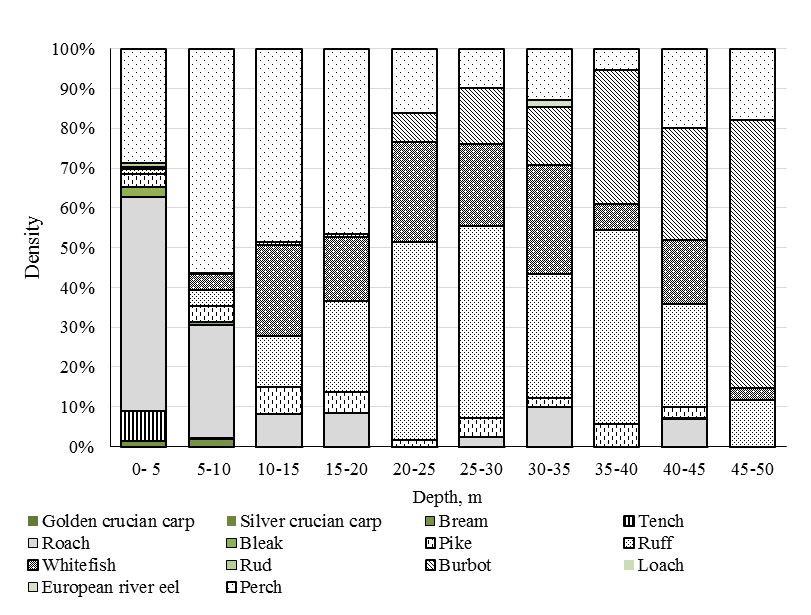
Fig. 5. Spatial structure of ichthyocenosis
Whitefish is found at depths of 5-40 m, its highest density is noted at 15-25 m, which is explained by the fact that whitefish is a representative of cold-loving fish (Fig. 6).
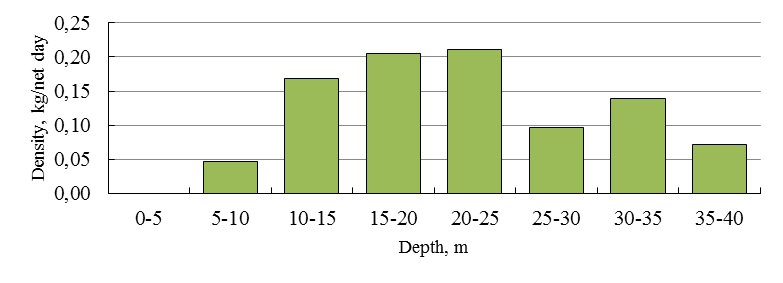
Fig. 6. Distribution of whitefish by depth
In the control catches, individuals ranging in size from 15 to 53 cm were noted. The basis of such catches is formed by individuals of 32-35 cm in size (Fig. 7), individuals larger than 42 cm were encountered singly.
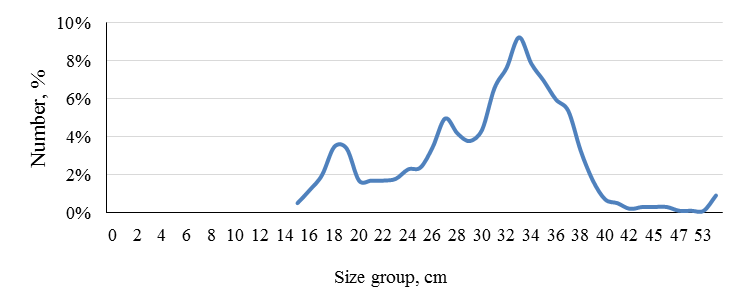
Fig. 7. Size structure of the whitefish population in Lake Vishtynetskoye during the study period
The average linear sizes of whitefish in commercial catches (caught with large-particle nets with a mesh size of 45 and 50 mm) in the period from 2000 to 2006 ranged from 30 to 38 cm, the average length during this period was 35.0 cm [10]. The average sizes of whitefish in Lake Vishtynetskoye in test catches in the period from 2017 to 2023 with the same fishing gear ranged from 33 to 38 cm, the average length was
34.4 cm (Fig. 8).
|
|
|
|
а |
b |
|
Fig. 8. Change in the average length of whitefish in commercial (a) [10] and control (b) catches in Lake Vishtynetskoye |
|
In the early 2000s, the weight of whitefish in commercial catches varied from 400 to 780 g, with an average weight of 595 g. The weight of individuals in the modern period fluctuates between 545 and 750 g, despite the fact that the maximum weight recorded in the period from 2017 to 2023 is less than in 2000-2006, the average weight of whitefish is now 644 g (Fig. 9).
|
|
|
|
а |
b |
|
Fig. 9. Change in the average weight of whitefish in commercial (a) [10] and control (b) catches in Lake Vishtynetskoye
|
|
The average age in catches ranged from 3 to 6 years, while in the early 2000s the basis of catches were younger individuals, the average age was 4.5 years, in the modern period the average age of fish is 5.0 years (Fig. 10).
|
|
|
|
а |
b |
|
Fig. 10. Change in the average age of whitefish in commercial (a) [10] and control (b) catches in Lake Vishtynetskoye |
|
Comparison of the linear, weight indicators and age of whitefish in catches in 45 and 50 mm nets in the early 2000s and in the modern period shows that the linear indicators of fish are now lower, but the weight and age have become somewhat higher. This can be explained by the fact that the habitat conditions of whitefish have now improved somewhat, and the intensification of fishing thins out the population and reduces competition for food resources.
Conclusion
In the modern period, the average catch of whitefish (over the last 5 years) is more than 0.9 tons, with a tendency to increase, in the early 2000s, catches fluctuated greatly from 0.1 tons to 2.0 tons, while the development of the TAC now exceeds 70%, which is 2 times more than in the earlier period. The average length is now slightly lower, but the weight indicators are 50 g higher, which indicates a stable state of the whitefish population and the absence of a negative impact on it from fishing, which confirms the correct value of the determined TAC.
1. Atlas presnovodnykh ryb Rossii [Atlas of freshwater fish of Russia]. Moscow, Nauka Publ., 2003. Vol. 1. 379 p.
2. Reshetnikov Iu. S. Ekologiia i sistematika sigovykh ryb [Ecology and systematics of whitefish]. Moscow, Nauka Publ., 1980. 300 p.
3. Ryby v zapovednikakh Rossii [Fish in Russian na-turereserves]. Moscow, Tovarishchestvo nauchnykh izdanii KMK, 2010. Vol. 1. Presnovodnye ryby. 627 p.
4. Bobra T. V., Naraev G. P., Bersiagin A. G. i dr. Zapovedniki – 2019. Biologicheskoe i landshaftnoe raznoobrazie, okhrana i upravlenie [Nature Reserves – 2019. Biological and landscape diversity, conservation and management]. Simferopol', IT «ARIAL» Publ., 2019. 433 p.
5. Cherniaev Zh. A. Vosproizvodstvo sigovykh ryb. Ekologo-fiziologicheskie osobennosti razmnozheniia i razvitiia [Reproduction of whitefish. Ecological and physiological features of reproduction and development]. Moscow, Tovarishchestvo nauchnykh izdanii KMK, 2017. 329 p.
6. Shibaev L. V., Shpokaite E. V. Kharakteristika nere-stovogo stada siga (Coregonus lavaretus L.) Kurshskogo zaliva [Characteristics of the spawning herd of whitefish (Coregonus lavaretus L.) of the Curonian Lagoon]. Izvestiia Kaliningradskogo gosudarstvennogo tekhnicheskogo universiteta, 2014, no. 32, pp. 91-98.
7. Anur'eva A. S., Shpokaite E. V., Shibaev L. V. Sravnenie morfometricheskikh pokazatelei dvukh ekologicheskikh form siga (Coregonus lavaretus L.) v vodoemakh [Comparison of morphometric indicators of two ecological forms of whitefish (Coregonus lavaretus L.) in reservoirs]. Izvestiia Kaliningradskogo gosudar-stvennogo tekhnicheskogo universiteta, 2012, no. 24, pp. 28-35.
8. Informatsiia ob osvoenii vydelennykh kvot [Infor-mation on the development of allocated quotas]. Available at: http://zbtu39.ru/informacziya-ob-osvoenii-vydelennyh-kvot/ (accessed: 15.04.2024).
9. Anur'eva A. S., Shibaev S. V. Biologicheskie para-metry populiatsii siga oz. Vishtynetskogo [Biological pa-rameters of the whitefish population in the Lake Vishtynetskoye]. Innovatsii v nauke, obrazovanii i biznese – 2012: X Mezhdunarodnaia nauchnaia konferentsiia (Kaliningrad, 17–19 oktiabria 2012 g.): trudy: v 3 ch. Kaliningrad, 2012. Part 1. Pp. 18-20.
10. Gushchin A. V., Fedorov V. E. Ekologicheskie problemy i rybolovstvo ozera Vishtynetskoe [Environmental problems and fisheries of Lake Vishtynetskoye]. Kaliningrad, FGU «Zapbaltrybvod», 2007. Pp. 83-87.
11. Mychkova A. V., Shibaev L. V. Biologicheskaia kharakteristika siga (Coregonus lavaretus L.) Kurshskogo zaliva v period nerestovoi migratsii [Biological characteris-tics of whitefish (Coregonus lavaretus L.) of the Curonian Lagoon during spawning migration]. Aktual'nye voprosy nauki, 2015, no. 17, pp. 128-131.
12. Bernikova T. A. Fiziko-geograficheskaia i gidro-logicheskaia kharakteristika [Physical, geographical and hydrological characteristics]. Ozero Vishtynetskoe. Kalinin-grad, IP «Mishutkina I. V.», 2008. Pp. 20-44.
13. Pravdin I. F. Rukovodstvo po izucheniiu ryb [A guide to the study of fish]. Moscow, Pishchepromizdat, 1966. 376 p.
14. Shibaev S. V., Sokolov A. V. Metod analiza ikhti-otsenozov malykh vodoemov Kaliningradskoi oblasti na osnove kontrol'nykh oblovov setnymi orudiiami lova [A method for analyzing ichthyocenoses of small reservoirs in the Kaliningrad region based on control catches with net fishing gear]. Trudy VNIRO, 2014, vol. 151, pp. 158-163.

